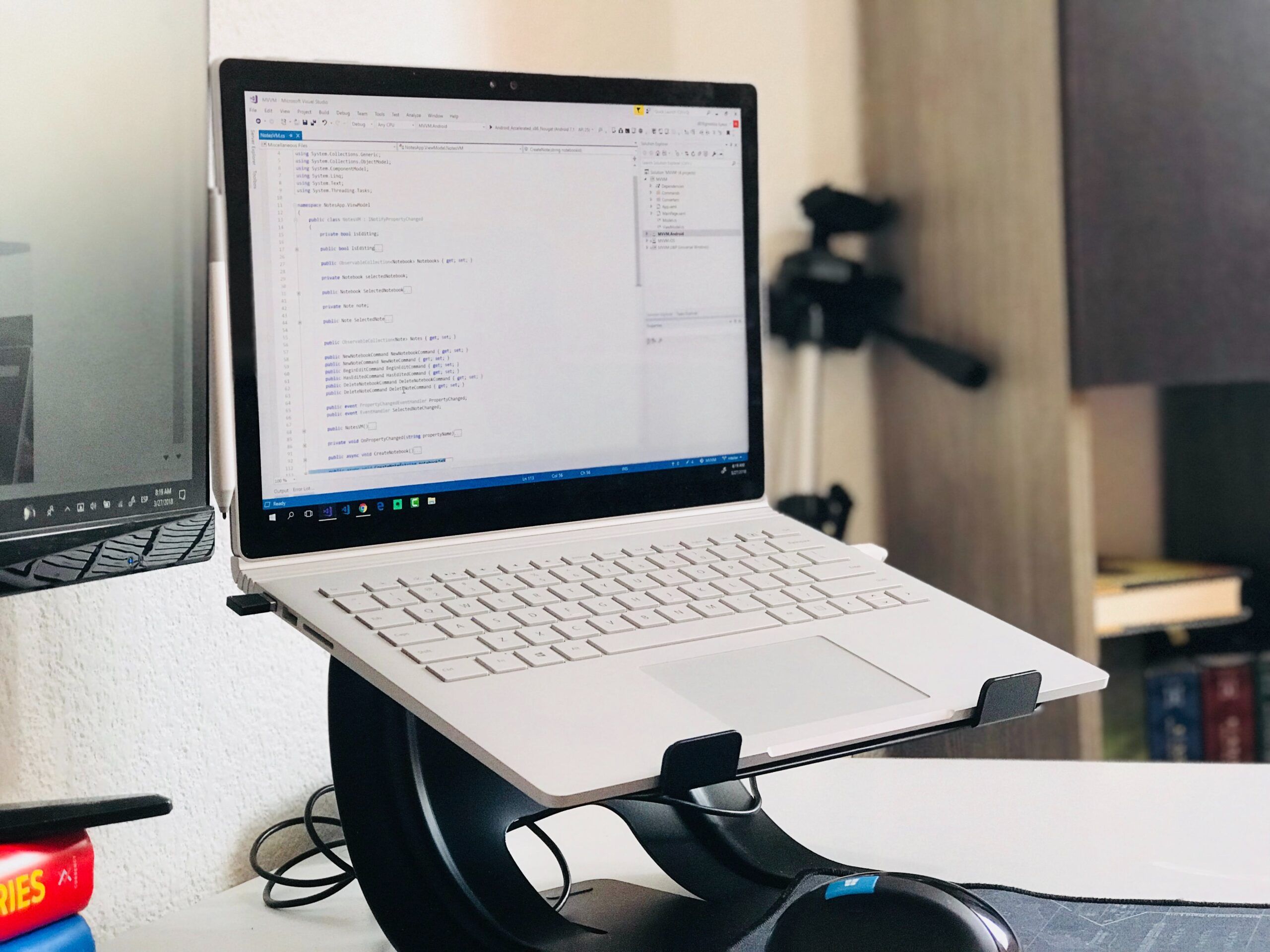Embracing Ergonomics: Working Safely with Display Screen Equipment (DSE)
From checking emails, proofreading a document, joining a meeting, or even sending a text – both our office work and daily routines are highly dependent on the use of display screen equipment (DSE). However, although this regular use of display screen equipment aids our productivity and efficiency levels, it also makes us vulnerable to potential health and well-being risks such as musculoskeletal issues, eye strain, and headaches.
However, with the right equipment, thorough safety assessments, and appropriate ergonomic practices, employers and employees alike can mitigate DSE-associated health risks in the office. In this blog post, we’ll explore these preventative and remedial measures while providing key insights on DSE safety. Let’s dive in!
Display Screen Equipment and Users:
There are many different types of display screen equipment in a modern office. This includes PCs (desktops or laptops), tablets and electronic notepads, interactive whiteboards, smartphones, and even EPOS (electronic point of sales systems) for transactions. An average office worker will use one or more of these technological tools every day, sometimes simultaneously. Indeed, the Health and Safety Executive classifies a DSE user as a worker who uses display screen equipment for continuous periods of one hour or more daily. This definition covers both office-based and remote workers, and it is these users who face DSE-related health risks and to whom DSE regulations and guidelines apply.
What are the potential health risks associated with DSE use?
A sedentary office routine with a desk job can make it hard to get adequate exercise, sunlight, and time away from technology. Employees who work on a computer or other display screen equipment can thus face many health and well-being challenges related to their working week. These include:
- Musculoskeletal disorders: Prolonged use of DSE can lead to back, neck, and shoulder pain from continuously looking down at a screen and sitting for extended periods without lumbar support.
- Carpal Tunnel Syndrome: Extensive and continuous use of a computer mouse and keyboard can cause wrist pain and trigger conditions such as carpal tunnel syndrome, where nerves in the hand and wrist are compressed, causing pain and numbness.
- Eye Strain: Constantly staring at a bright screen can cause serious visual discomfort and may impair eyesight. The prolonged exposure to a bright screen and reduced blinking can also make our eyes drier.
- Headaches: Bright screens and artificial lighting from computers and other technological tools can trigger headaches and migraines from the glare of a screen or any flashing or flickering visual displays.
- Stress: DSE usage can also cause stress and mental health issues, as DSE users can feel the pressure to remain constantly connected or online. Work-related updates/notifications on computers or smartphones outside working hours can also trigger stress and damage your team’s work-life balance.
While facilitating work-related tasks and allowing for automated efficiency, display screen equipment can seriously impact its users’ mental and/or physical health. The regulations surrounding DSE usage aim to counteract and prevent these issues.
An in-depth survey conducted by the Institute of Occupational Health across a range of different organisations and 1327 randomly selected office workers found that 52% of DSE users reported headaches, 58% reported eye strain, and 47% reported neck and shoulder pain. These symptoms were highest amongst DSE users who worked long periods without taking regular breaks. As technology usage grows, these problems will inevitably only become more prevalent. This underlines just how important it is for all employers to be proactive in their attempts to limit these risks.
What are the regulations surrounding the use of DSE?
The 1992 Health and Safety Regulations Act on Display Screen Equipment legally mandates all employers to make provisions for DSE safety as a means to reduce employee health risks. Under this act, it is your responsibility to provide DSE users with:
- An adequate workstation for their display screen equipment
- Training on using the display screen equipment
- An eye test for users experiencing eye strain
- Regular breaks and time away from the screen
These provisions must be made for all DSE users, including office workers, remote workers, or those working in a hybrid set-up. Compliance with these regulations helps mitigate the possibility of musculoskeletal issues, eye problems, and pressure on the nervous system.
So, how can you adhere to these regulations and take the best steps possible to safeguard the health and wellbeing of your employees?
Guidelines for Employers: Maximising DSE Safety
There are many steps you can take to follow regulations and boost the health and well-being of DSE users in their workplaces. Our recommendations for the most effective practices are:
★ Adequate risk assessments
As an employer, you should conduct regular risk assessments to ensure that DSE workstations are as ergonomic, user-friendly, and comfortable as possible. You must conduct an assessment when a new workstation is set up, an existing station is changed, or when a user reports discomfort or pain. Your employees can then be provided with a checklist with questions relating to whether their keyboards are legible and securely placed, how close their mice are positioned to them, and whether their screens are bright enough, able to tilt, and free from glaring and/or flickering.
★ Providing ergonomic equipment:
Following the assessment, you should ensure your employees’ equipment is as ergonomically friendly as possible. Office chairs should be adequately cushioned to provide lumbar support, have adjustable heights, and comfortable armrests. The height of computer monitors should also be adjustable, with anti-glare filters in place to reduce eyestrain. You should also provide additional lighting through desk lamps and offer footrests for further support and comfort.
★ Open office layouts:
A more open office layout can encourage movement and allow your team to get up, move around, and stretch their muscles. You should ensure desks and workstations are organised in sunny, larger rooms to prevent overcrowding and stuffiness.
★ Eye tests:
As mentioned above, all employers are legally mandated to provide eye tests for employees experiencing ocular discomfort, strain, dryness, or temporary short-sightedness. These tests should be arranged with an optometrist. You should reimburse employees for these costs if they prefer to arrange an appointment with their own optician.
★ Breaks and screen limits:
Limits on screen time can help alleviate the health risks associated with DSE usage. For example, you could schedule office breaks for employees at regular intervals (e.g., 15-minute breaks after every hour of DSE usage). Similar provisions should also be made for remote employees. Installing a form of software on your team’s computers which limits their working screen time outside of office hours or reminds them to take breaks throughout the day can help prevent continuous usage and remind them that taking breaks is important.
★ Consulting experts:
You should always consult occupational health experts to help optimise DSE safety in your workplace.
At Osteopaths For Industry, our trained experts offer:

Guidelines for Employees: Individual Steps for DSE Safety
There’s lots we can all do to protect our health and wellbeing while working with display screen equipment. At OFI, our top recommendations for employees are:
✓ To actively participate in DSE training:
As an employer, you are mandated to provide training on how employees can operate and manage their display screen equipment. Employees should be encouraged to attend these training sessions regularly as software/technological updates can lead to changes in their equipment. In these sessions, they should be encouraged to ask questions, flag any issues, and discuss the technicalities of different types of equipment. The training sessions can also help employees learn to spot signs of DSE-related health issues, such as eye strain, and to remain vigilant of such risks when using their equipment.
✓ To take individual precautions:
In addition to following their management’s guidelines, employees should also take individual precautions to protect their health as DSE users. This can mean wearing prescription glasses as and when necessary, engaging in stretching exercises to relax their muscles and improve posture, incorporating self-care practices like mindfulness exercises, and avoiding screen time during breaks.
✓ To ask for support:
Lastly, but perhaps most importantly, employees shouldn’t feel hesitant about asking you for provisions and support. They should feel able to report any signs of DSE-related discomfort to their managers. For example, an employee experiencing back pain should inform their line manager and request a chair with lumbar support. Similarly, any visual discomfort or eye strain should be reported, and the employee should request an eye test. It’s imperative that employees feel supported to regularly raise wellbeing needs with management and inquire about the provisions available.
You and your employees can thus work together to ensure that DSE-related discomfort and health risks are adequately assessed, identified, and resolved to keep DSE users happy, healthy, and productive.
Conclusion:
As technology advances, the modern working landscape is constantly changing and adapting to incorporate different types of display screen equipment in everyday tasks. With the drive to constantly increase productivity and efficiency in office work comes rapidly rising levels of screen time, sedentary activity, and associated health risks for DSE users. Therefore, as offices embrace technology and all it can offer our working practices, we must also embrace ergonomic practices to assess, prevent, and combat DSE safety risks. We have explored how both employers and employees can take advantage of ergonomic equipment, instil DSE-friendly practices such as limited screen time and regular breaks, provide and engage in training, identify support needs, and seek help in the form of eye tests, improved equipment, and expert services. We hope you found these insights helpful and that the guidelines and information outlined in this blog post will leave you and your employees even better informed about DSE safety.








